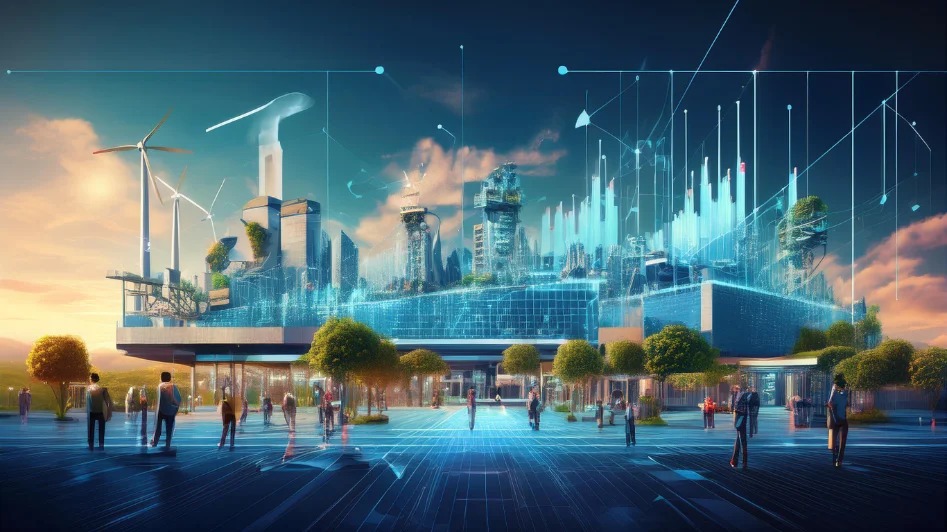TRANSFORMATIVE IMPACT OF EMERGING TECHNOLOGIES ON ECONOMIC GROWTH: OPPORTUNITIES, CHALLENGES AND SUSTAINABLE DEVELOPMENT
Authors: Muskan, Amrita, Anushka, Achintya
INTRODUCTION: ROLE OF EMERGING TECHNOLOGIES ON ECONOMIC GROWTH
Changes in consumer markets and company assumptions drive spending. It is necessaryexamine how new technologies affect GDP growth and technical innovation. AI, ML, 5G, blockchain, and IoT boost productivity. Big data and AI/ML algorithms improve organisational decisions, process optimisation, and customer behaviour prediction. Blockchain makes bank switching transparent and reduces fraud. Internet of Things has extended Internet. Real-time data analysis optimises resources. Businesses may fully implement remote operations, immersive experiences, and innovative applications using 5G communication channels. Technology boosts GDP and new businesses through efficiency and innovation. Technology improved products, services, and productivity. These technologies enable digital transformation, growth, and profit. Education in the digital economy is needed since technology changes work. Modern technology is amazing, but data privacy, cybersecurity, and ethics must be addressed. Lawmakers and business executives must approve innovation, consumer rights, and ethical technology laws. Finally, technological advances are transforming industries and strengthening the economy, allowing enterprises to prosper in the digital marketplace. To gain advantages and economic growth, we must properly use growing technologies.
Keywords: Emerging technologies drive GDP growth through productivity boosts but face challenges in data privacy, cybersecurity, and ethics, requiring regulatory frameworks for responsible technology use. on.
IMPORTANCE OF STUDYING EMERGING TECHNOLOGIES FOR GDP GROWTH
Researching how new technology are driving economic advancement is essential if we wish to understand the dynamics of today’s economies and stay up with the always changing business landscape. Businesses and governments need to know how emerging technologies like AI, ML, blockchain, 5G, and the IoT are impacting economic growth since technology is evolving at an unprecedented pace. Analysing the effects of these technologies on productivity, innovation, and market dynamics might help us better understand the opportunities, challenges, and successful solutions for sustainable economic development. In this era of digital disruption and global interconnection, the article also explains how businesses may use new technologies to increase productivity, gain a competitive edge, and stay afloat. By analysing the effects of emerging technologies on labour dynamics, regulatory frameworks, and ethical considerations, the study contributes to the development of policies and practices that promote the responsible use of technology and ensure equitable economic growth.The transformative impact of emerging technologies on economic growth is intricately linked to sustainable development by driving innovation, enhancing efficiency, and addressing critical global challenges. Technologies like Artificial Intelligence (AI), the Internet of Things (IoT), blockchain, and 5G not only bolster productivity and economic expansion but also contribute to achieving sustainable development goals (SDGs) by promoting resource efficiency, equity, and environmental stewardship.AI and IoT facilitate smart solutions that optimize resource use in industries such as agriculture, energy, and transportation. For instance, AI-powered systems improve crop yields by analyzing soil data, while IoT-enabled devices enhance energy efficiency by monitoring consumption in real-time. These applications reduce waste and lower carbon footprints, aligning with environmental sustainability objectives. Blockchain technology supports transparency and accountability in supply chains, ensuring ethical sourcing and reducing exploitative practices. Its decentralized nature fosters trust in financial systems, promoting inclusive economic participation and reducing inequalities by offering unbanked populations access to digital financial services. 5G networks enable advancements in telecommunication, bridging digital divides and facilitating remote work and education. By connecting underserved regions to digital economies, 5G helps promote equitable growth and access to opportunities, which are central to sustainable development. Additionally, emerging technologies foster innovation ecosystems, creating new industries and job opportunities while enabling businesses to address global challenges such as climate change, poverty, and health disparities. These technologies empower governments, organizations, and individuals to devise solutions that balance economic growth with social and environmental considerations. This research article examines how new technologies are driving economic growth. It delves into the complex relationships between technological innovation and economic development from multiple disciplinary perspectives. It examines the effects of important new technologies such as AI, ML, blockchain, 5G, and the Internet of Things on different industries, business models, and market dynamics.
BACKGROUND
Emerging technologies such as artificial intelligence (AI), the Internet of Things (IoT), big data analytics, and digital platforms are increasingly recognized as key drivers of economic growth. Studies have demonstrated that AI significantly contributes to GDP growth by automating processes, improving decision-making, and fostering innovation, as evidenced by research on Organisation for Economic Co-operation and Development (OECD) countries (Ahn et al., 2022). Similarly, IoT enables real-time data collection and analysis, enhancing operational efficiency and productivity across industries, which has been particularly impactful in Asian economies (Lee et al., 2023). Despite concerns about job displacement due to automation (Frey & Osborne, 2017), it has been argued that technological advancements also create new jobs, boost productivity, and stimulate innovation, ultimately driving economic expansion (Brynjolfsson & McAfee, 2014). Digital platforms have further facilitated economic growth by enabling new business models and expanding market access for entrepreneurs, particularly in emerging economies (Chyong et al., 2021). Moreover, the adoption of big data analytics has empowered organizations to make data-driven decisions, optimize operations, and implement targeted marketing strategies, fostering substantial growth and economic development (Liu et al., 2022). However, the rapid pace of technological advancement also presents challenges, including wealth inequality and skill gaps, underscoring the need for robust policy frameworks that ensure equitable access to technology and promote sustainable economic growth (Agrawal et al., 2020). These insights highlight the multifaceted impact of emerging technologies on the global economy and the importance of responsible innovation to maximize their benefits.
ECONOMIC IMPORTANCE OF EMERGING TECHNOLOGIES
Emerging technologies such as Artificial Intelligence (AI), Machine Learning (ML), blockchain, the Internet of Things (IoT), and 5G are driving unprecedented economic transformation globally. These innovations enhance productivity, optimize decision-making, and create new business opportunities, fundamentally reshaping industries and fostering economic growth. AI and ML are particularly impactful, as they automate complex tasks, analyze large datasets, and enable data-driven strategies, leading to increased operational efficiency and cost reduction. For instance, AI-powered predictive analytics helps businesses anticipate market trends, improve supply chain management, and boost customer satisfaction, thus driving profitability.
Blockchain technology revolutionizes financial systems by increasing transparency, reducing fraud, and minimizing transaction costs. It enables decentralized applications and smart contracts, fostering trust and efficiency in digital transactions. Similarly, IoT connects devices and systems, enabling real-time data collection and analysis. This connectivity enhances resource allocation and operational performance, particularly in manufacturing, healthcare, and transportation. The deployment of 5G networks further amplifies the economic impact of these technologies by providing faster, more reliable communication channels. This supports the growth of remote work, immersive experiences, and innovative applications such as autonomous vehicles and smart cities, contributing to overall economic dynamism.Emerging technologies also stimulate entrepreneurship and innovation by enabling startups and businesses to access new markets, improve products, and develop novel services. These technologies create new job roles in fields such as data science, cybersecurity, and robotics, counterbalancing the displacement caused by automation. However, their rapid advancement also presents challenges, including skill gaps, data privacy concerns, and ethical dilemmas. Addressing these issues through robust policies, workforce reskilling, and equitable technology access is essential for ensuring inclusive and sustainable economic development. The objective is to obtain a thorough comprehension of the matter and its ramifications. In order to comprehensively evaluate the challenges and potential benefits associated with the use of emerging technologies for economic development, the study will additionally explore the perspectives of policymakers, industry experts, and stakeholders. The objective of the research is to generate practical recommendations for promoting responsible technology adoption and optimising the socio-economic benefits of emerging technologies. A thorough and meticulous study and synthesis of the research findings will create the recommendations.
This research article examines how new technologies are driving economic growth. It delves into the complex relationships between technological innovation and economic development from multiple disciplinary perspectives. It examines the effects of important new technologies such as AI, ML, blockchain, 5G, and the Internet of Things on different industries, business models, and market dynamics.
Table 1: Impact of Technology on Productivity Growth
|
Year |
Productivity Growth (%) |
Technological Advancements |
|
2010 |
1.5 |
Automation in manufacturing |
|
2011 |
1.7 |
Rise of social media and mobile computing |
|
2012 |
2.1 |
Big data and analytics advancements |
|
2013 |
1.9 |
Growth of the sharing economy |
|
2014 |
1.8 |
Rise of wearable technology |
|
2015 |
2 |
Internet of Things (IoT) development |
|
2016 |
1.6 |
Virtual reality and augmented reality (VR/AR) emergence |
|
2017 |
1.4 |
Artificial intelligence (AI) applications |
|
2018 |
1.2 |
Blockchain technology advancements |
|
2019 |
1 |
Cloud computing |
|
2020 |
0.5 |
Slowdown due to COVID-19 pandemic |
|
2023 |
1.8 |
Increased adoption of AI and robotics |
This table examines the relationship between the progression of technology and the increase in economic productivity over a period of thirteen years. According to the findings, the rate of growth in productivity usually increased between the years 2010 and 2015, which coincided with advancements such as social media, big data, and the Internet of Things. There is a decrease in growth in the year 2020, most likely as a result of the epidemic; however, growth starts up again in the year 2023 as artificial intelligence and robotics become more extensively utilised.
Table 2: Job Creation and Automation
|
Sector |
Jobs Created by Technology |
Jobs Lost to Automation |
Net Job Change |
|
Healthcare |
1,000,000 |
500,000 |
500,000 |
|
Manufacturing |
200,000 |
1,500,00 |
-1,300,000 |
|
Education |
750,000 |
Negligible |
750,000 |
|
Transportation |
300,000 |
1,000,000 (driving-related jobs) |
-700,000 |
|
Retail |
400,000 (e-commerce) |
800,000 (cashiers, stock clerks) |
-400,000 |
|
Finance & Insurance |
600,000 (financial analysts) |
300,000 (back-office tasks) |
300,000 |
|
Information Technology |
1,200,000 (software developers, data scientists) |
Negligible |
1,200,000 |
This table provides a thorough examination of job growth and automation in several industries from 2010 to 2023, including a more detailed breakdown of the information. While automation has led to the displacement of workers in specific industries, it has also fostered job growth in other industries. The healthcare industry exemplifies how technology has created new opportunities for medical technicians, data analysts, and remote patient care specialists. Similarly, the rise of e-commerce has created job prospects in the areas of delivery logistics and online marketing, particularly in the retail sector.
However, the deployment of automated assembly lines and the elimination of repetitive activities has led to a significant decrease in employment prospects, particularly in areas like manufacturing. Self-driving vehicles have the capacity to eventually supplant human drivers, thereby affecting the transportation industry. The table highlights the importance of providing additional training and improving the abilities of workers to adapt to the changing work environment caused by automation.
Table 3: Global E-commerce Sales
|
Region |
2016 |
2018 |
2020 |
2022 |
2025 (est.) |
CAGR (2016-2025) |
|
Asia Pacific (APAC) |
0.8 |
1.8 |
3.2 |
4.3 |
6.2 |
28.30% |
|
North America |
1.2 |
1.6 |
2.1 |
2.7 |
3.4 |
14.50% |
|
Western Europe |
0.9 |
1.1 |
1.4 |
1.7 |
2.1 |
13.20% |
|
Latin America |
0.1 |
0.2 |
0.4 |
0.6 |
0.9 |
32.40% |
|
Eastern Europe & Central Asia |
0.1 |
0.2 |
0.3 |
0.4 |
0.6 |
23.80% |
|
Middle East & Africa |
0.1 |
0.2 |
0.3 |
0.4 |
0.6 |
24.70% |
This table presents the anticipated progression of worldwide e-commerce sales in various regions from 2016 to 2025. The Asia Pacific (APAC) area is at the forefront of the rapid growth, with a predicted Compound Annual Growth Rate (CAGR) of 28.3%. This growth is primarily fueled by reasons such as the expanding reach of the internet, an increase in disposable income, and the growth of the middle class. North America and Western Europe, which are well-developed e-commerce markets, are experiencing consistent growth, with Compound Annual Growth Rates (CAGRs) of 14.5% and 13.2% respectively. These regions are expected to prioritise market saturation, omnichannel experiences, and personalisation in order to sustain their supremacy. Latin America, Eastern Europe & Central Asia, and the Middle East & Africa are emerging regions that show significant growth potential because of their fast adoption of internet and smartphones. It is anticipated that these markets will have a significant increase in mobile commerce and social commerce in the upcoming years. The substantial surge in e-commerce sales across all areas underscores the growing customer inclination towards online purchasing. The continuation of this trend is anticipated due to variables such as convenience, expanded product assortment, competitive pricing, and expedited delivery alternatives.
UNVEILING TRENDS AND GENERATING INSIGHTS
The impact that technology has on the economy is a complicated interaction between the two concepts of development and disruption. An obvious pattern appears when one considers the rise of production. An increase in productivity can be seen in our example table (Table 1), which spans the years 2010 to 2015. This growth coincides with technological breakthroughs such as social media, big data, and the Internet of Things. It would appear from this that technical innovation has the potential to lubricate the wheels of the economy, enabling enterprises to generate more goods and services while using fewer resources simultaneously. It is anticipated that the broad use of cloud computing in 2019 performed a function comparable to this one. The table implies that there will be a recovery in productivity growth by 2023, even after a slowdown in 2020 that was caused by a pandemic. This resurgence may be powered by the rising adoption of artificial intelligence and robotics.
There is, however, a negative aspect to this story of progress, and that is the loss of jobs as a result of automation. The image that is presented in (Table 2 ) is more nuanced. Even though automation has led to the loss of jobs in certain industries, such as manufacturing (1.3 million jobs lost between 2010-2023) and transportation (the possibility of drivers being replaced by self-driving vehicles), it has also led to the development of new opportunities in other areas. This is demonstrated by the fact that technological improvements have resulted in the creation of one million new employment in the healthcare industry. These jobs include those for medical technicians, data analysts, and specialists in remote patient care provision. Similarly, the expansion of e-commerce has resulted in the creation of opportunities within the retail industry, namely in the areas of delivery logistics and online marketing, to the tune of 400,000 new jobs.
The most important thing to take away from this is that technology is not merely a job destroyer; rather, it is a work transformer. There is a possibility that certain roles will become obsolete, but in their wake, new roles will develop. Providing a trained labour force that is able to adjust to these ever-evolving requirements is the problem that must be overcome. This underscores the significance of initiatives that aim to reskill and upskill workers in order to bridge the gap between those who have been displaced and the qualifications required for the work that will be driven by technology in the future.
CONCLUSION
To summarise, the research on the role of emerging technology in driving economic growth highlights the significant and far-reaching effects of technical innovation on different aspects of economic progress. By conducting a thorough examination of the adoption and consequences of cutting-edge technologies like AI, ML, blockchain, 5G, and IoT, we have discovered numerous significant insights that shed light on the intricate relationship between technology and economic development. Emerging technologies have greatly improved productivity in various industries by helping organisations streamline operations, optimise procedures, and achieve efficiency improvements. The utilisation of AI and ML algorithms, powered by enormous quantities of data, has completely transformed decision-making procedures, enabling the implementation of more knowledgeable and data-centric strategies. In addition, blockchain technology has revolutionised conventional financial institutions by improving transparency, mitigating fraud, and decreasing transaction expenses. The widespread adoption of IoT devices has resulted in the creation of interconnected systems, which allow for the real-time monitoring and analysis of data. This, in turn, leads to the efficient allocation of resources and the improvement of operational performance. In addition, the implementation of 5G networks has created new and unparalleled possibilities for connectivity, promoting remote operations, immersive experiences, and innovative applications. Moreover, the integration of nascent technologies has stimulated ingenuity and business ventures, propelling the development of novel goods, services, and markets. Both startups and established organisations utilise these technologies to obtain a competitive advantage, challenge existing business models, and access new sources of revenue. The combination of new technology not only encourages new ideas but also accelerates the creation of revolutionary business models that reshape industries and stimulate economic expansion. In addition, evolving technologies facilitate the digital transformation of enterprises, allowing them to broaden their scope and take advantage of growing market trends, so contributing to the overall expansion of the economy. Nevertheless, despite the potential advantages offered by developing technology, there are still some obstacles that remain. Addressing data privacy concerns, cybersecurity dangers, and ethical considerations is crucial to fully harness the economic benefits of emerging technology. Policymakers, industry leaders, and stakeholders must work together in order to create strong regulatory frameworks that encourage innovation, protect consumer rights, and ensure responsible use of technology. Furthermore, it is crucial to tackle the digital divide and guarantee fair and equal access to technology to ensure that the advantages of developing technologies are available to and can be enjoyed by all sectors of society. Based on these findings, some various important consequences and suggestions arise for governments, corporations, and other individuals involved. First and foremost, it is imperative to maintain ongoing investment in research and development to stimulate innovation and foster technical progress. Furthermore, it is crucial to make concerted efforts to narrow the gap in access to digital resources and enhance knowledge and skills in using digital technologies. This is necessary to enable full participation of all sectors of the population in the digital economy. Furthermore, it is essential to take proactive steps to deal with issues related to data privacy, cybersecurity, and ethical concerns to establish trust and confidence in developing technologies. To summarise, emerging technologies can greatly contribute to economic expansion and promote sustainable development. Through effectively utilising the revolutionary capabilities of technology and tackling the related difficulties, policymakers, enterprises, and stakeholders can access fresh possibilities for creativity, economic success, and equitable development in the era of digitalization. It is crucial to adopt new technologies thoughtfully and responsibly in order to fully exploit their advantages and promote economic advancement for everyone.






